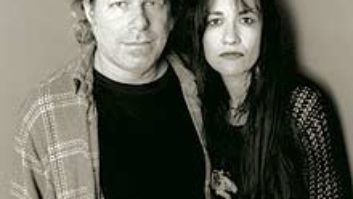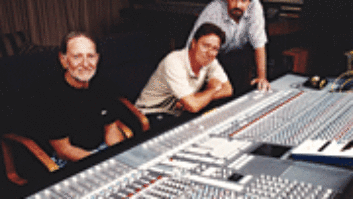“On this record, the white elephant in the closet was: Are we going to come up with another hit? We didn’t even consider that on the last record,” explains producer John Leventhal of Shawn Colvin’s Whole New You release. “So, it’s interesting how we dealt with that. I think we sort of, for better or worse, tried to grab the brass ring.”
While the longtime songwriting team of Colvin and Leventhal turned in a collection of radio-friendly folk/pop songs this time around, there were two songs that they nudged for Top 40 radio consideration. Of course, those two songs — “Whole New You” and “Anywhere You Go” — would have never even warranted that sort of treatment had Colvin’s “Sunny Came Home” not been the phenomenon it was in 1997. That song shot up the charts, earned the team a Grammy and rocked her into a new level of stardom. As if that wasn’t enough to deal with, Colvin found herself in uncharted waters with a new husband and baby. “It was a different framework for her in which to write lyrics,” Leventhal explains. “She tends to write lyrics that come from a personal place, although I think people assume her lyrics are about her, and they are and they aren’t. I think it took her awhile to understand what she wanted to write about.”
Colvin’s quest for lyrics gave Leventhal a chance to work on music. “We had a lot of the music in place before the lyrics were finalized, which was a little unusual and not optimum for record making,” he admits. Although, he adds, the initial creative bursts are his favorite times. “I find my best ideas come when it’s spontaneous and I’m really unconscious. There’s no judgment attached. I’ve really figured out over the years that that is my best stuff.” Once those ideas have been hatched, Leventhal will get them onto tape right away. “If I put one little thing down, I’ll want to put another little thing down, because I’ll get excited and inspired. Nine times out of 10, that ends up being what’s on the record — if not that actual performance, a version of it.”
Those early sessions are tracked at Leventhal’s own 12th Street Studios in Manhattan. Laughing, the producer admits that the studio is not exactly a technical wonderland — “Very embarrassing for all your technical readers. At this point, I’m thoroughly humiliated by my totally not hip set up,” he says. Actually, the Leventhal gear list is nothing to be ashamed of — it includes 24 tracks of 20-bit ADAT, outboard gear including mic pre’s by Daking and Millennia Media, a Distressor, UREI 1176 and Tube-Tech compressors, Apogee D/A converters and a fine selection of microphones: a couple of Neumann 67s, an AKG C-60, Neumann CMV563, Shure 57s, Beyerdynamic M88s, Geffel and a couple of Coles ribbon mics. “Those are quite great on drums, overheads, room mics,” he says of the Coles. “I like ’em on percussion. I saw the pictures in The Beatles’ recording book and I was like, ‘I need those.’ I’m a huge Beatles fan and Ringo’s drums just always sounded so cool.”
Even after reporting the gear list, Leventhal says, “This is not my area of expertise, please put that in the interview. There are producers that the gear thing is it and they can go on and on. It’s not that I don’t respect that, because I think it’s kind of seductive, but I don’t find it all that interesting. Life is too short for me to get too deep into that.”
That’s a point he drives home while discussing his drum programming tools. “It’s going to be embarrassing. I have this version of Performer from before you were born,” he says. “I have an Akai 950 12-bit sampler and a Roland R-8.” Often, he’ll run those tracks through filters or a bit of analog delay. If he needs to cut a live drum track, more often than not the studio drummer will play to a percussion track he’s built. “It’s more musical and it’s more fun. It will give more of a sense of what the tune is about,” he explains.
While Pro Tools was used during the recording of the Colvin sessions — mostly for editing out performances Leventhal knew he wouldn’t need — the producer isn’t yet a convert. “I would like to get Pro Tools, and I’m sure I would find it worlds easier and creative and inspiring,” he says. “But I guess I’m a little afraid of getting sucked into the Pro Tools vacuum, which is sitting in front of a computer screen and watching music instead of hearing it. I’ve seen very musical people end up staring at their computer screen, and you can’t help but get seduced by what Pro Tools has to offer. I’m not knocking it, because I can see the benefit of it. I’m just not sure it’s the best thing at the end of the day for me.
“What I really like to do is play, so I’m not sure if I want to play four bars and then loop it,” he continues. And play he does. On this disc, Tom Schick handled the bulk of the engineering, while Leventhal played and produced. There are pros and cons, he suggests, of producing yourself. “Sometimes I wonder if it would be good to have a little editor on top of me, sort of checking out what I’m doing,” Leventhal says. “I trust myself at this point and I trust my intuitive sense about stuff. I think the hardest part for me, since I enjoy the process so much and I can play a bunch of instruments — I should say I own a bunch of instruments, I can make noise on a variety of instruments — that I’m concerned that I’m doing too much.”
He’s heard those accusations, especially in the case of an artist like Colvin, and acknowledges them. “A lot of people perceive her as a folk artist,” he explains. “They are more than happy to hear just an acoustic guitar and her voice, which, of course, the record company isn’t remotely interested in hearing. So finding that middle ground where you’re doing something compelling in the pop music sense, but not losing the essence of who she is, can be a little challenging.”
A song such as “Nothing Like You,” where Leventhal played all of the instruments, was an interesting study in his musical habits. The initial idea for the song came well after the midway point of the album, which is not unusual for him. “Almost every record I do where I’m involved in the writing, at some point during the course of the making of the record I start to want to write more songs. Particularly if I’m getting a sense that we’re missing an element. On this record, it was that we needed a good old acoustic guitar-based song.” He put some ideas down on tape, played it for Colvin over the phone and the next time they got together, she had some melodic ideas, some lyrics and a title. Inspired, Leventhal continued to work alone at the 12th Street Studio. “What I discovered in that case was that I was really liking what I was doing in my home studio. I figured I could go all the way with this and it might have a charm to it that it wouldn’t have if I went in with a drummer and a bass player and tried to re-create this.”
“Nothing Like You” and “Matter of Minutes” were two of the easier tracks for Leventhal to work on during the recording. The rest of the album was more challenging. “I think we both felt like we didn’t want to repeat ourselves,” he reports. “It’s that thing of wanting to stretch a little bit, but you want to stay true to who you are. You don’t want to stretch just to do that. You want to come up with something that’s really fresh, but something that’s really compelling and true to the artist. Also, Shawn wasn’t as confident as she’s been in the past, which can’t help but make the producer feel like it’s not the right song or the right production.”
Specifically, “One Small Year” tested him, because it was different from anything else either had done. “The phrasing seems different, the kind of track it is is different for me.” Indeed, Leventhal says it was inspired by such idiosyncratic pop stalwarts as Brian Wilson, Burt Bacharach and Randy Newman, so it’s no surprise that the song has such a non-traditional musical bed. “I wasn’t at all sure that Shawn was going to like it, but she liked it quite a bit,” he notes. “She had the melodic bit in the verse and the phrase ‘one small year’ very early on, but it took her a long time to come up with the lyric for it and to feel honest about singing it. I think she felt it was a little contrived. It’s a strange tune. The production is a little more linear and it was really challenging.”
Just as important as the music is the quality of Colvin’s vocal tracks. Many of the vocal sessions took place at Leventhal’s studio, with the balance done at Shelter Island Sound in New York. The music tracks were mostly recorded at Sear Sound. For Colvin’s vocal, a Neumann 67 handled most of the load, with the signal running through a Distressor. Finding the right microphone is particularly crucial, Leventhal says, when he’s producing a singer/songwriter-type of artist. “I get feedback when people say, ‘God, the vocal is so great and centered.’ I say, ‘Well, I just make it louder than anything else.’ If you listen to my records, I think the vocals are louder than on most people’s records. I wouldn’t mind working with someone like the Rolling Stones, where Mick was always apparently wanting his vocal to be softer. That’s a lot easier, because you just get the track up. The challenge is to come up with a track that has some substance and some power to it with a really loud vocal. It’s not always that easy. I think that is my particular cross to bear.”
Production always involves juggling different sets of expectations — from the artist, the label and the fans. This album was no exception. “There were any number of directions we could have gone on this record,” Leventhal says. And that includes the pair of tunes they aimed toward radio. “Maybe we should have done that or maybe we shouldn’t have done it. Talk to me at the end of the year to see if we’ve had a hit. If we haven’t had a hit, maybe it wasn’t the right thing to do. Maybe we should have not even concerned ourselves with radio. It’s not like we bent over backward!”
Yet the pressure was huge and the issue is complicated by the fact that the radio landscape has changed considerably since “Sunny Came Home” was on the charts. “Then it’s complicated even more by the fact that Shawn is a 45-year-old woman with a child. It’s not that I pay super-attention to these things, but I can’t help but notice that there haven’t been any 40-year-old women on the charts since we were on the charts, except for maybe Cher,” he says laughing. “So, it’s kind of a funny position to be in, and she’s got two strikes against her, demographically speaking. So we’ll see what happens. I’m starting to have some small regrets that I paid any attention to Top 40 radio in my thinking, and I think Shawn may feel the same way, but sometimes you’ve got to do these things to discover it.”






